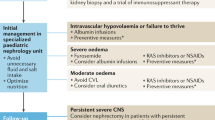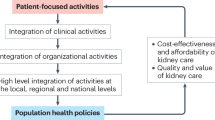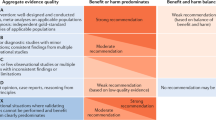Abstract
To mark World Kidney Day 2016, Nature Reviews Nephrology invited six leading researchers to highlight the key advances and challenges within their specialist field of paediatric nephrology. Here, advances and remaining challenges in the fields of prenatal patterning, acute kidney injury, renal transplantation, genetics, cardiovascular health, and growth and nutrition, are all discussed within the context of paediatric and neonatal patients with kidney disease. Our global panel of researchers describe areas in which further studies and clinical advances are needed, and suggest ways in which research in these areas should progress to optimize renal care and long-term outcomes for affected patients.
This is a preview of subscription content, access via your institution
Access options
Subscribe to this journal
Receive 12 print issues and online access
$209.00 per year
only $17.42 per issue
Buy this article
- Purchase on Springer Link
- Instant access to full article PDF
Prices may be subject to local taxes which are calculated during checkout





Similar content being viewed by others
References
Little, M. H. Kidney Development, Disease, Repair and Regeneration (Elsevier Academic Press, 2016).
Park, J. -S. & McMahon, A. P. in Kidney Development, Disease, Repair and Regeneration (ed Little, M. H.) 67–74 (Elsevier Academic Press, 2016).
Bertram, J. F., Douglas-Denton, R. N., Diouf, B., Hughson, M. D. & Hoy, W. E. Human nephron number: implications for health and disease. Pediatr. Nephrol. 26, 1529–1533 (2011).
Zhang, Z. et al. A common RET variant is associated with reduced newborn kidney size and function. J. Am. Soc. Nephrol. 19, 2027–2034 (2008).
Hughson, M., Farris, A. B. 3rd, Douglas-Denton, R., Hoy, W. E. & Bertram J. F. Glomerular number and size in autopsy kidneys: the relationship to birth weight. Kidney Int. 63, 2113–2122 (2003).
Costantini, F. in Kidney Development, Disease, Repair and Regeneration (ed Little, M. H.) 41–56 (Elsevier Academic Press, 2016).
Oxburgh, L. in Kidney Development, Disease, Repair and Regeneration (ed Little, M. H.) 75–86 (Elsevier Academic Press, 2016).
Park, J. -S. & Kopan, R. in Kidney Development, Disease, Repair and Regeneration (ed Little, M. H.) 87–93 (Elsevier Academic Press, 2016).
McMahon, A. P. et al. GUDMAP: the genitourinary developmental molecular anatomy project. J. Am. Soc. Nephrol. 19, 667–671 (2008).
Harding, S. D. et al. The GUDMAP database — an online resource for genitourinary research. Development 138, 2845–2853 (2011).
Luyckx, V. A. et al. Effect of fetal and child health on kidney development and long-term risk of hypertension and kidney disease. Lancet 382, 273–283 (2013).
Moritz, K. M. in Kidney Development, Disease, Repair and Regeneration (ed Little, M. H.) 177–190 (Elsevier Academic Press, 2016).
Nicolaou, N., Renkema, K. Y., Bongers, E. M., Giles, R. H. & Knoers, N. V. Genetic, environmental, and epigenetic factors involved in CAKUT. Nat. Rev. Nephrol. 11, 720–731 (2015).
Beeman, S. C. et al. MRI-based glomerular morphology and pathology in whole human kidneys. Am. J. Physiol. Renal 306, F1381–F1390 (2014).
Sutherland, M. R. et al. Accelerated maturation and abnormal morphology in the preterm neonatal kidney. J. Am. Soc. Nephrol. 22, 1365–1374 (2011).
Sutherland, S. M. et al. AKI in hospitalized children: epidemiology and clinical associations in a national cohort. Clin. J. Am. Soc. Nephrol. 8, 1661–1669 (2013).
Sanchez-Pinto, L. N., Goldstein, S. L., Schneider, J. B. & Khemani, R. G. Association between progression and improvement of acute kidney injury and mortality in critically ill children. Pediatr. Crit. Care Med. 16, 703–710 (2015).
Kidney Disease: Improving Global Outcomes (KDIGO). KDIGO clinical practice guideline for acute kidney injury. Kidney Int. Suppl. 2, 1–138 (2012).
Kellum, J. A., Bellomo, R. & Ronco, C. Kidney attack. JAMA 307, 2265–2266 (2012).
Goldstein, S. L. & Chawla, L. S. Renal angina. Clin. J. Am. Soc. Nephrol. 5, 943–949 (2010).
Basu, R. K. et al. Derivation and validation of the renal angina index to improve the prediction of acute kidney injury in critically ill children. Kidney Int. 85, 659–667 (2014).
Basu, R. K. et al. Incorporation of biomarkers with the renal angina index for prediction of severe AKI in critically ill children. Clin. J. Am. Soc. Nephrol. 9, 654–662 (2014).
Basu, R. K. et al. Assessment of Worldwide Acute Kidney Injury, Renal Angina and Epidemiology in critically ill children (AWARE): study protocol for a prospective observational study. BMC Nephrol. 16, 24 (2015).
Hui-Stickle, S., Brewer, E. D. & Goldstein, S. L. Pediatric ARF epidemiology at a tertiary care center from 1999 to 2001. Am. J. Kidney Dis. 45, 96–101 (2005).
Zappitelli, M., Moffett, B. S., Hyder, A. & Goldstein, S. L. Acute kidney injury in non-critically ill children treated with aminoglycoside antibiotics in a tertiary healthcare centre: a retrospective cohort study. Nephrol. Dial. Transplant. 26, 144–150 (2011).
Goldstein, S. L. et al. Electronic health record identification of nephrotoxin exposure and associated acute kidney injury. Pediatrics 132, e756–e767 (2013).
Askenazi, D. J., Ambalavanan, N. & Goldstein, S. L. Acute kidney injury in critically ill newborns: what do we know? What do we need to learn? Pediatr. Nephrol. 24, 265–274 (2009).
White, S. L. et al. Is low birth weight an antecedent of CKD in later life? A systematic review of observational studies. Am. J. Kidney Dis. 54, 248–261 (2009).
Ronco, C. et al. Continuous renal replacement therapy in neonates and small infants: development and first-in-human use of a miniaturised machine (CARPEDIEM). Lancet 383, 1807–1813 (2014).
Coulthard, M. G. et al. Haemodialysing babies weighing <8 kg with the Newcastle infant dialysis and ultrafiltration system (Nidus): comparison with peritoneal and conventional haemodialysis. Pediatr. Nephrol. 29, 1873–1881 (2014).
Frei, U. & Schober-Halstenberg, H. -J. Nierenersatztherapie in Deutschland. Bericht über Dialysebehandlung und Nierentransplantation in Deutschland. Bundesverband Niere E.V. [online], (2008).
Foster, B. J. Heightened graft failure risk during emerging adulthood and transition to adult care. Pediatr. Nephrol. 30, 567–576 (2015).
Foster, B. J. et al. Association between age and graft failure rates in young kidney transplant recipients. Transplantation 92, 1237–1243 (2011).
Watson, A. R. Non-compliance and transfer from paediatric to adult transplant unit. Pediatr. Nephrol. 14, 469–472 (2000).
Prestidge, C., Romann, A., Djurdjev, O. & Matsuda-Abedini, M. Utility and cost of a renal transplant transition clinic. Pediatr. Nephrol. 27, 295–302 (2012).
Harden, P. N. et al. Bridging the gap: an integrated paediatric to adult clinical service for young adults with kidney failure. BMJ 344, e3718 (2012).
Kreuzer, M. et al. The TRANSNephro-study examining a new transition model for post-kidney transplant adolescents and an analysis of the present health care: study protocol for a randomized controlled trial. Trials 15, 505 (2014).
Brunkhorst, L. C. et al. Efficacy and safety of an everolimus- versus a mycophenolate mofetil-based regimen in pediatric renal transplant recipients. PLoS ONE 10, e0135439 (2015).
Ahlenstiel-Grunow, T. et al. A multicenter, randomized, open-labeled study to steer immunosuppressive and antiviral therapy by measurement of virus (CMV, ADV, HSV)-specific T cells in addition to determination of trough levels of immunosuppressants in pediatric kidney allograft recipients (IVIST01-trial): study protocol for a randomized controlled trial. Trials 15, 324 (2014).
Miettinen, J. et al. Donor-specific HLA antibodies and graft function in children after renal transplantation. Pediatr. Nephrol. 27, 1011–1019 (2012).
Einecke, G. et al. Antibody-mediated microcirculation injury is the major cause of late kidney transplant failure. Am. J. Transplant. 9, 2520–2531 (2009).
Billing, H. et al. Successful treatment of chronic antibody-mediated rejection with IVIG and rituximab in pediatric renal transplant recipients. Transplantation 86, 1214–1221 (2008).
Hartmann, H. et al. Early kidney transplantation improves neurocognitive outcome in patients with severe congenital chronic kidney disease. Transpl. Int. 28, 429–436 (2015).
Offner, G. et al. Kidney transplanted children come of age. Kidney Int. 55, 1509–1517 (1999).
Devuyst, O., Knoers, N. V., Remuzzi, G. & Schaefer, F. Rare inherited kidney diseases: challenges, opportunities, and perspectives. Lancet 383, 1844–1859 (2014).
Sadowski, C. E. et al. A single-gene cause in 29.5% of cases of steroid-resistant nephrotic syndrome. J. Am. Soc. Nephrol. 26, 1279–1289 (2015).
Lipska, B. S. et al. Genotype–phenotype associations in WT1 glomerulopathy. Kidney Int. 85, 1169–1178 (2014).
Cramer, M. T. et al. Expanding the phenotype of proteinuria in Dent disease. A case series. Pediatr. Nephrol. 29, 2051–2054 (2014).
Weber, S. et al. Prevalence of mutations in renal developmental genes in children with renal hypodysplasia: results of the ESCAPE study. J. Am. Soc. Nephrol. 17, 2864–2870 (2006).
Bockenhauer, D. & Jaureguiberry, G. HNF1B-associated clinical phenotypes: the kidney and beyond. Pediatr Nephrol. http://dx.doi.org/10.1007/s00467-015-3142-2 (2015).
Wong, E. K., Goodship, T. H. & Kavanagh, D. Complement therapy in atypical haemolytic uraemic syndrome (aHUS). Mol. Immunol. 56, 199–212 (2013).
Heeringa, S. F. et al. COQ6 mutations in human patients produce nephrotic syndrome with sensorineural deafness. J. Clin. Invest. 121, 2013–2024 (2011).
Korkmaz, E. et al. ADCK4-associated glomerulopathy causes adolescence-onset FSGS. J. Am. Soc. Nephrol. 27, 63–68 (2015).
Nicolaou, N., Renkema, K. Y., Bongers, E. M., Giles, R. H. & Knoers, N. V. Genetic, environmental, and epigenetic factors involved in CAKUT. Nat. Rev. Nephrol. 11, 11720–11731 (2015).
Dart, A. B., Ruth, C. A., Sellers, E. A., Au, W. & Dean, H. J. Maternal diabetes mellitus and congenital anomalies of the kidney and urinary tract (CAKUT) in the child. Am. J. Kidney Dis. 65, 684–691 (2015).
USRDS. USRDS 2011 annual data report: atlas of chronic kidney disease and end-stage renal disease in the United States. [online], (2011).
Borzych, D. et al. The bone and mineral disorder of children undergoing chronic peritoneal dialysis. Kidney Int. 78, 1295–1304 (2010).
Shroff, R., Long, D. A. & Shanahan, C. Mechanistic insights into vascular calcification in CKD. J. Am. Soc. Nephrol. 24, 179–189 (2013).
Shroff, R. et al. Dialysis accelerates medial vascular calcification in part by triggering smooth muscle cell apoptosis. Circulation 118, 1748–1757 (2008).
Ragnauth, C. D. et al. Prelamin A acts to accelerate smooth muscle cell senescence and is a novel biomarker of human vascular aging. Circulation 121, 2200–2210 (2010).
Goodman, W. G. et al. Coronary-artery calcification in young adults with end-stage renal disease who are undergoing dialysis. N. Engl. J. Med. 342, 1478–1483 (2000).
J. Oh et al. Advanced coronary and carotid arteriopathy in young adults with childhood-onset chronic renal failure. Circulation 106, 100–105 (2002).
Brady, T. M. et al. Carotid intima-media thickness in children with CKD: results from the CKiD study. Clin. J. Am. Soc. Nephrol. 7, 1930–1937 (2012).
Kupferman, J. C. et al. BP control and left ventricular hypertrophy regression in children with CKD. J. Am. Soc. Nephrol. 25, 167–174 (2014).
Khouzam, N. M., Wesseling-Perry, K. & Salusky, I. B. The role of bone in CKD-mediated mineral and vascular disease. Pediatr. Nephrol. 30, 1379–1388 (2015).
Denburg, M. R. et al. Fracture burden and risk factors in childhood CKD: results from the CKiD Cohort Study. J. Am. Soc. Nephrol. http://dx.doi.org/10.1681/ASN.2015020152 (2015).
Salusky, B. et al. Sevelamer controls parathyroid hormone-induced bone disease as efficiently as calcium carbonate without increasing serum calcium levels during therapy with active vitamin D sterols. J. Am. Soc. Nephrol. 16, 2501–2508 (2005).
KDIGO. Clinical practice guideline for the diagnosis KDIGO evaluation, prevention, and treatment of chronic kidney disease-mineral and bone disorder (CKD-MBD). Kidney Int. 76 (Suppl. 113), S1 (2009).
Hahn, D. & Hodson, E. M., & Craig, J. C. Interventions for metabolic bone disease in children with chronic kidney disease. Cochrane Database Syst. Rev. 11, CD008327 (2015).
Querfeld, U. et al. The Cardiovascular Comorbidity in Children with Chronic Kidney Disease (4C) study: objectives, design, and methodology. Clin. J. Am. Soc. Nephrol. 5, 1642–1648 (2010).
Guthrie, L. G. Chronic interstitial nephritis in childhood. Lancet 149, 585 (1897).
Furth, S. L., Stablein, D., Fine R. N., Powe, N. R. & Fivush, B. A. Adverse clinical outcomes associated with short stature at dialysis initiation: a report of the North American Pediatric Renal Transplant Cooperative study. Pediatrics 109, 909–913 (2002).
Rosenkranz, J. et al. Psychosocial rehabilitation and satisfaction with life in adults with childhood-onset of end-stage renal disease. Pediatr. Nephrol. 20, 1288–1294 (2005).
Martz, K. & Stablein, D. M. North American Pediatric Renal Trials and Cooperative Studies (NAPRTCS) 2008 annual report. Emmes [online], (2008).
Rodig, N. M. et al. Growth in children with chronic kidney disease: a report from the Chronic Kidney Disease in Children Study. Pediatr. Nephrol. 29, 1987–1995 (2014).
North American Pediatric Renal Trials and Cooperative Studies (NAPRTCS) 2011 annual dialysis report. Emmes [online], (2011).
North American Pediatric Renal Trials and Cooperative Studies (NAPRTCS) 2014 annual transplant report. Emmes [online], (2014).
Karlberg, J. et al. Early age-dependent growth impairment in chronic renal failure. Pediatr. Nephrol. 10, 283–287 (1996).
NKF-KDOQI clinical practice guideline for nutrition in children with CKD. Am. J. Kidney Dis. 53 (Suppl. 2), S1–S124 (2009).
Wong, C. S. et al. Anthropometric measures and risk of death in children with end-stage renal disease. Am. J. Kidney Dis. 36, 811–819 (2000).
Mak, R. H., Cheung, W. W. & Roberts, C. T. Jr. The growth hormone-insulin-like growth factor-I axis in chronic kidney disease. Growth Horm. IGF Res. 18, 17–25 (2008).
Mehls, O. et al. Long-term growth hormone treatment in short children with CKD does not accelerate decline of renal function: results from the KIGS registry & ESCAPE trial. Pediatr. Nephrol. 30, 2145–2151 (2015).
Fischbach, M. et al. Daily online haemodiafiltration promotes catch-up growth in children on chronic dialysis. Nephrol Dial. Transplant. 25, 867–873 (2010).
Watson, A. R. et al. Transition from pediatric to adult renal services: a consensus statement by the International Society of Nephrology (ISN) and the International Pediatric Nephrology Association (IPNA). Pediatr. Nephrol. 26, 1753–1757 (2011).
Acknowledgements
The authors would like to thank their colleagues in the field and the efforts of the World Kidney Day initiative, for which the focus for 2016 is “Kidney Disease & Children. Act Early to Prevent It”. J.F.B. is supported by grants from the National Health and Medical Research Council (NHMRC) of Australia, the Diabetes Australia Research Trust (DART), and Monash University. S.L.G. has received funding from the agency for Healthcare Research (grant numbers AHRQ CERT 1U19HS021114 and AHRQ 1R18HS023763-01), the Casey Lee Ball Foundation, and the National Institute for Diabetes, Digestive and Kidney Diseases (grant number NIH P50 DK096418). L.P. has received support for this work from the KfH Foundation for Preventive Medicine. F.S. has received support for this work from the EU 7th Framework Programme (grant number 2012–305608), the KfH Foundation for Preventive Medicine, and the Research Programme of the European Renal Association–European Dialysis and Transplant Association. R.C.S. was supported by the National Institute for Health Research Biomedical Research Centre at Great Ormond Street Hospital for Children NHS Foundation Trust and University College London. B.A.W. receives support from the National Institute of Diabetes and Digestive and Kidney Diseases, with additional funding from the Eunice Kennedy Shriver National Institute of Child Health and Human Development and the National Heart, Lung and Blood Institute (grants UO1-DK-66143, UO1-DK-66174, UO1-DK-82194, and UO1-DK-66116).
Author information
Authors and Affiliations
Contributions
All authors contributed equally to the preparation of this manuscript.
Corresponding authors
Ethics declarations
Competing interests
S.L.G. has received research grants and consultancy fees, and is a member of the expert panel and speaker's bureau for Baxter and Gambro Renal Products, is a consultant for Akebia, Bellco, and AM Pharma, and is a member of the steering committee for trials for both Otsuka and La Pharmaceuticals. L.P. has received travel support and speaker honoraria from Alexion, Novartis, and Raptor as well as research grants from Novartis. F.S. has received consultancy fees and speaker honoraria from Alexion. R.C.S. has received speaker honoraria from Fresenius Medical Care and Amgen. B.A.W. has received speaker honoraria from Alexion and consultancy fees from Amgen. J.F.B. declares no competing interests.
Related links
Related links
FURTHER INFORMATION
Rights and permissions
About this article
Cite this article
Bertram, J., Goldstein, S., Pape, L. et al. Kidney disease in children: latest advances and remaining challenges. Nat Rev Nephrol 12, 182–191 (2016). https://doi.org/10.1038/nrneph.2015.219
Published:
Issue Date:
DOI: https://doi.org/10.1038/nrneph.2015.219
This article is cited by
-
Insufficient application of estimation equations of glomerular filtration rate: a survey of 1009 Chinese pediatricians
World Journal of Pediatrics (2022)
-
Determinants of growth after kidney transplantation in prepubertal children
Pediatric Nephrology (2021)
-
Dietary calcium intake does not meet the nutritional requirements of children with chronic kidney disease and on dialysis
Pediatric Nephrology (2020)
-
Clinical value of ambulatory blood pressure in pediatric patients after renal transplantation
Pediatric Nephrology (2018)
-
Transplantatversagen
Der Nephrologe (2018)



